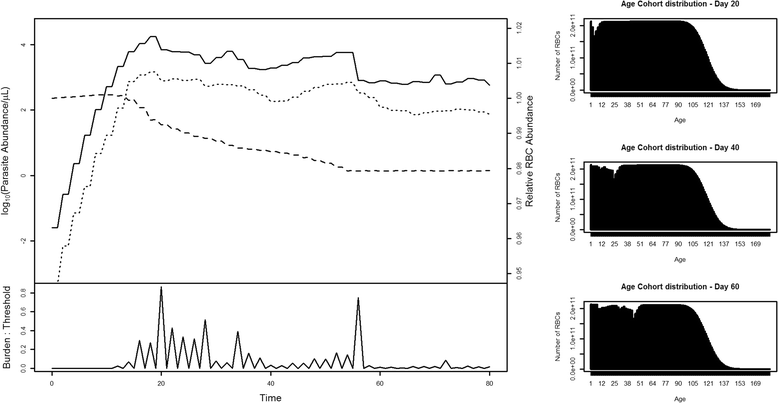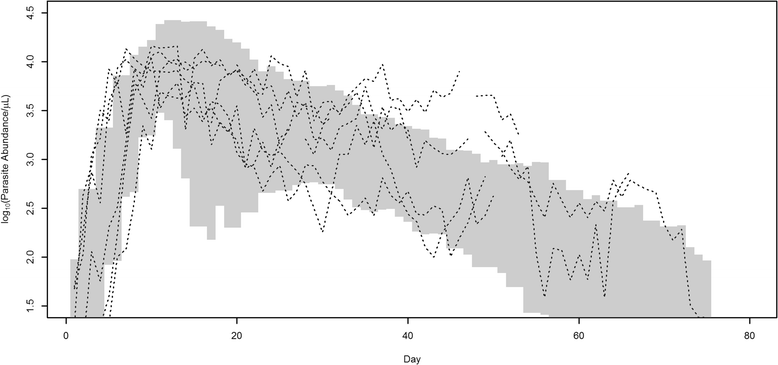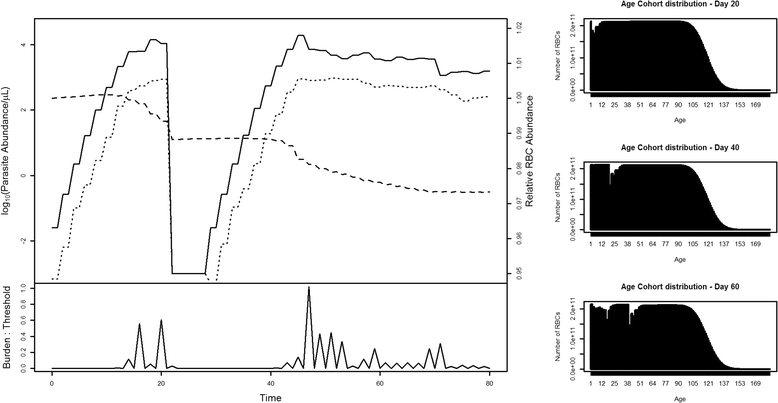A simulation model of the within-host dynamics of Plasmodium vivax infection
- PMID: 25652017
- PMCID: PMC4323116
- DOI: 10.1186/s12936-015-0580-z
A simulation model of the within-host dynamics of Plasmodium vivax infection
Abstract
Background: The benign reputation of Plasmodium vivax is at odds with the burden and severity of the disease. This reputation, combined with restricted in vitro techniques, has slowed efforts to gain an understanding of the parasite biology and interaction with its human host.
Methods: A simulation model of the within-host dynamics of P. vivax infection is described, incorporating distinctive characteristics of the parasite such as the preferential invasion of reticulocytes and hypnozoite production. The developed model is fitted using digitized time-series' from historic neurosyphilis studies, and subsequently validated against summary statistics from a larger study of the same population. The Chesson relapse pattern was used to demonstrate the impact of released hypnozoites.
Results: The typical pattern for dynamics of the parasite population is a rapid exponential increase in the first 10 days, followed by a gradual decline. Gametocyte counts follow a similar trend, but are approximately two orders of magnitude lower. The model predicts that, on average, an infected naïve host in the absence of treatment becomes infectious 7.9 days post patency and is infectious for a mean of 34.4 days. In the absence of treatment, the effect of hypnozoite release was not apparent as newly released parasites were obscured by the existing infection.
Conclusions: The results from the model provides useful insights into the dynamics of P. vivax infection in human hosts, in particular the timing of host infectiousness and the role of the hypnozoite in perpetuating infection.
Figures



Similar articles
-
Modelling the contribution of the hypnozoite reservoir to Plasmodium vivax transmission.Elife. 2014 Nov 18;3:e04692. doi: 10.7554/eLife.04692. Elife. 2014. PMID: 25406065 Free PMC article.
-
Relapses of Plasmodium vivax infection result from clonal hypnozoites activated at predetermined intervals.J Infect Dis. 2007 Apr 1;195(7):934-41. doi: 10.1086/512242. Epub 2007 Feb 26. J Infect Dis. 2007. PMID: 17330782
-
An Activation-Clearance Model for Plasmodium vivax Malaria.Bull Math Biol. 2020 Feb 12;82(2):32. doi: 10.1007/s11538-020-00706-1. Bull Math Biol. 2020. PMID: 32052192
-
Plasmodium vivax pre-erythrocytic stages and the latent hypnozoite.Parasitol Int. 2021 Dec;85:102447. doi: 10.1016/j.parint.2021.102447. Epub 2021 Aug 30. Parasitol Int. 2021. PMID: 34474178 Review.
-
Reticulocytes: Plasmodium vivax target cells.Biol Cell. 2013 Jun;105(6):251-60. doi: 10.1111/boc.201200093. Epub 2013 May 2. Biol Cell. 2013. PMID: 23458497 Review.
Cited by
-
Treatment of pigs with endectocides as a complementary tool for combating malaria transmission by Anopheles farauti (s.s.) in Papua New Guinea.Parasit Vectors. 2019 Mar 19;12(1):124. doi: 10.1186/s13071-019-3392-0. Parasit Vectors. 2019. PMID: 30890165 Free PMC article.
-
Variation in relapse frequency and the transmission potential of Plasmodium vivax malaria.Proc Biol Sci. 2016 Mar 30;283(1827):20160048. doi: 10.1098/rspb.2016.0048. Proc Biol Sci. 2016. PMID: 27030414 Free PMC article.
-
Relapses of Plasmodium vivax malaria threaten disease elimination: time to deploy tafenoquine in India?BMJ Glob Health. 2021 Feb;6(2):e004558. doi: 10.1136/bmjgh-2020-004558. BMJ Glob Health. 2021. PMID: 33619041 Free PMC article. No abstract available.
-
Effectiveness of a Malaria Surveillance Strategy Based on Active Case Detection during High Transmission Season in the Peruvian Amazon.Int J Environ Res Public Health. 2018 Nov 27;15(12):2670. doi: 10.3390/ijerph15122670. Int J Environ Res Public Health. 2018. PMID: 30486449 Free PMC article.
-
Plasmodium vivax Controlled Human Malaria Infection - Progress and Prospects.Trends Parasitol. 2017 Feb;33(2):141-150. doi: 10.1016/j.pt.2016.11.001. Epub 2016 Dec 10. Trends Parasitol. 2017. PMID: 27956060 Free PMC article. Review.
References
-
- Mendis K, Sina BJ, Marchesini P, Carter R. The neglected burden of Plasmodium vivax malaria. Am J Trop Med Hyg. 2001;64:97–106. - PubMed
Publication types
MeSH terms
LinkOut - more resources
Full Text Sources
Other Literature Sources

